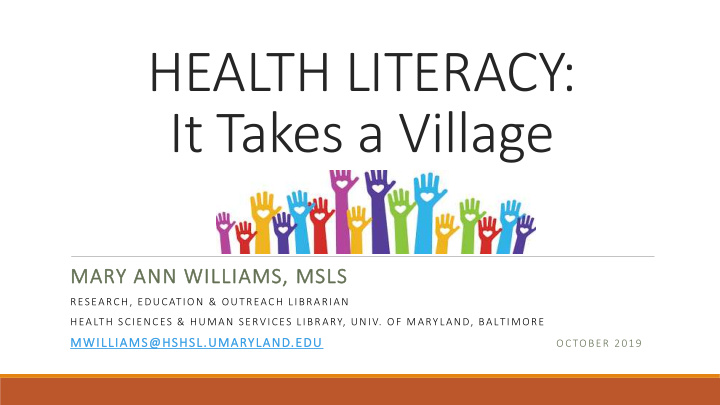



HEALTH LITERACY: It Takes a Village MARY ANN WILLIAMS, MSLS RESEARCH, EDUCATION & OUTREACH LIBRARIAN HEALTH SCIENCES & HUMAN SERVICES LIBRARY, UNIV. OF MARYLAND, BALTIMORE MWILLIAMS@HSHSL.UMARYLAND.EDU OCTOBER 2019
October is Health Literacy Month!
Health Literacy The degree to which individuals have the capacity to: ◦ obtain ◦ process ◦ understand basic health information and services needed to make appropriate health decisions - Health Literacy: A Prescription to End Confusion , IOM, 2004
Populations With Greater Likelihood of Lower Health Literacy: ◦ Immigrants ◦ Minorities ◦ Low income ◦ Low education level ◦ Limited English Proficiency (LEP) ◦ Elderly The Health Literacy of America’s Adults: Results from the 2003 National Assessment of Adult Literacy http://nces.ed.gov/pubs2006/2006483.pdf
Other Populations With Greater Likelihood of Lower Health Literacy: ◦ Learning Disabilities ◦ Autism ◦ Dyslexia ◦ Cognitive Disabilities
No one is exempt! Even YOU can experience instances where understanding & acting upon medical information or navigating the healthcare systems is challenging
Factors associated with low health literacy
Numeracy Speaking Listening Health Li Literacy Reading Understanding
Factors That May Hinder Understanding: ◦ Intimidation, fear, vulnerability ◦ Shock upon hearing a diagnosis ◦ Extenuating stressors within the patient's family ◦ Multiple health conditions to understand and treat
Factors That May Hinder Understanding: o Medical Ja Jargon: The language of medicine adds to the degree of difficulty. lacidem nograj sekam it erom tluciffid to daer, dnatsrednu and ekam erachtlaeh snoisiced.
Factors That May Hinder Understanding: o Use of numbers (Numeracy): probability, risk o Unfamiliar symbols and abbreviations o Reading level of patient education materials/ discharge instructions medication labels, etc.
Factors That May Hinder Obtaining Basic Health Services o Identifying healthcare services (challenge for the best of us) o Forms: applications, insurance, consent forms o Healthcare setting: maps, directories, signs posted, instructions, unfamiliar phrases o Availability of personal computers/computer literacy
Implications of low health literacy
Patients with low health literacy Less Likely to: Seek help early in the course of a disease Engage in self-care and chronic- disease management Keep appointments Share personal health information accurately
Patients with low health literacy Less Likely to: Understand mathematical concepts such as probability and risk Take medications properly Understand instructions (discharge, test prep, etc.) Navigate the healthcare system and setting
Impacts of Low Health Literacy
Economic Impact: Higher Healthcare Costs The cost of low health literacy to the U.S. economy is between $106 billion to $238 billion annually. http://publichealth.gwu.edu/departments/healthpolicy/CHPR/downloads/Lo wHealthLiteracyReport10_4_07.pdf
Identifying persons with low health literacy
Overestimate what patients/clients/customers are able to read and understand • Can’t tell by appearance • Number of years of schooling does not correlate with literacy skills • Adults with low literacy skills are adept at hiding it
Red Flags Incomplete or inaccurately completed forms Frequently misses appointments Taking medication incorrectly “I forgot my glasses. I’ll read this when I get home.” “Let me bring this home so I can discuss it with my children.” Flickr: felibrilu
BEST PRACTICES FOR CLEAR HEALTH COMMUNICATION
U.S. Literacy Facts The average adult reads at an eighth-grade level About 20% of adults read at the fifth-grade level and below (about 62 million) The Health Literacy of America’s Adults: Results from the 2003 National Assessment of Adult Literacy http://nces.ed.gov/pubs2006/2006483.pdf
U.S. Health Literacy Fact Most health-related materials are written at high school reading level or higher
Three Essential Aspects of Clear Health Communication • Know your “audience” • Treat every person with respect • Provide written materials in plain language
Worth Repeating 40-80% of medical information provided by healthcare practitioners is forgotten immediately . ! Source: J R Soc Med.2003 May; 96(5): 219 – 222.
Verbal & Written Recommendations Plain Language – common words/short words Short sentences = 15 words or less Avoid polysyllabic words whenever possible Explain what is meant by vague terms
Written Recommendations Use the second person — " you " or " your child " (not “the patient”) Font: size and type (Times New Roman) Ample white space
Verbal Recommendation Ask open ended questions • How are you taking this medication? • What are your symptoms? • What kind of information about your care are you looking for?
Recommendations for Increasing Behavior Change • Whose behavior are you trying to change? • What do you want them to DO? • Describe immediate benefits (what’s it in for them ) • Check for understanding (teach-back method)
Other Factors Which May Contribute to Low Health Literacy : Social Determinants of Health Conditions in the places where people live, learn, work, and play affect a wide range of health risks and outcomes. 1
Other Factors Which May Contribute to Low Health Literacy : Health Care Disparities Typically refers to differences between groups related to: • health insurance coverage • access to and use of care • quality of care
Other Factors Which May Contribute to Low Health Literacy : Culture/Belief Systems
Become a Health Literacy Advocate • Form partnerships & collaborate to improve: o Programs /Services o Policies o Legislation • Take an active role in asserting your right to receive health information in an understandable way
Mary Ann Williams mwilliams@hshsl.umaryland.edu
Questions? Comments? Thoughts?
Recommend
More recommend